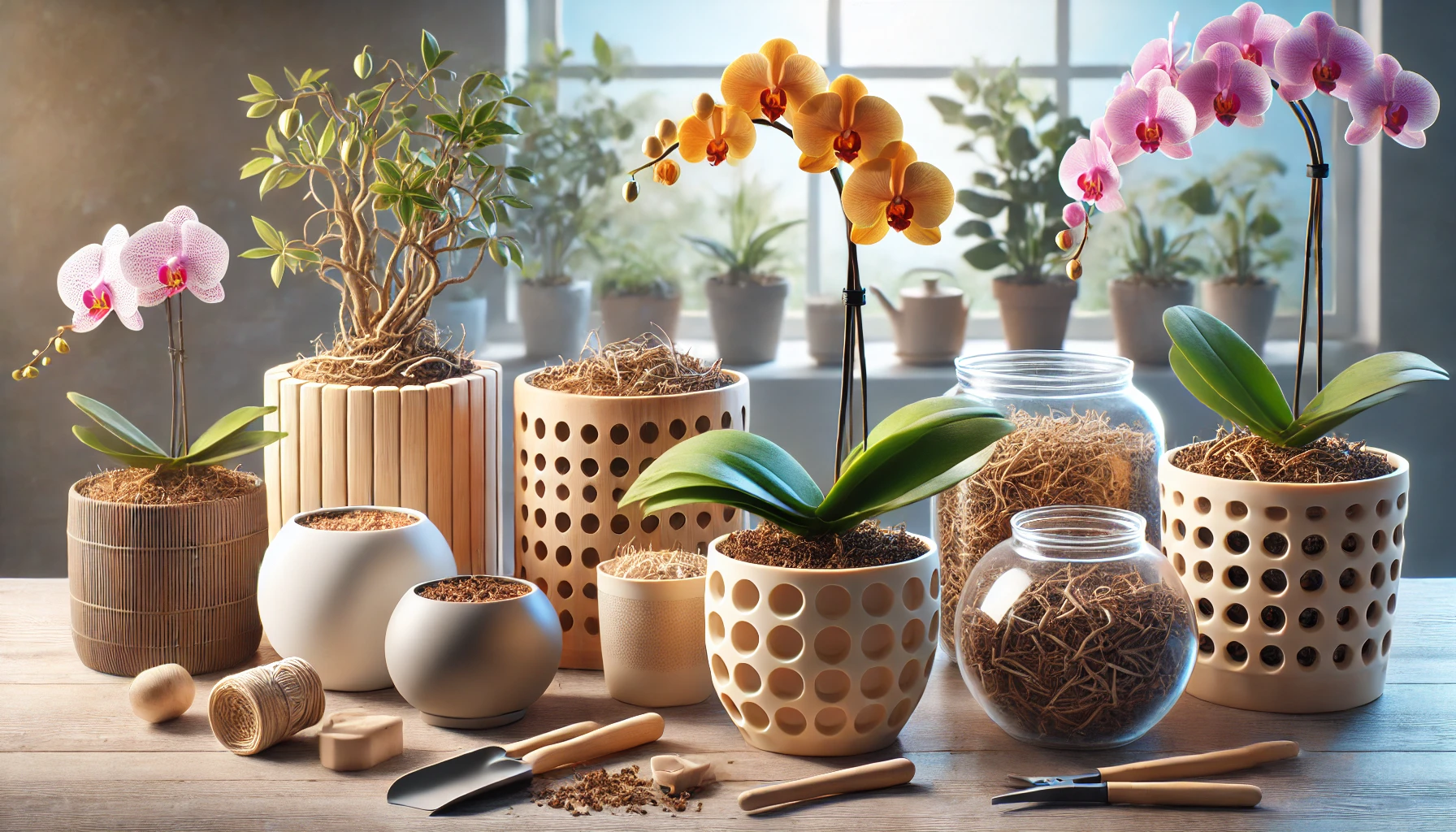Choosing the right pot for your orchid is essential for maintaining healthy roots, proper drainage, and good airflow. Unlike regular houseplants, orchids have aerial roots that need ventilation and moisture control to thrive. The wrong pot can lead to root rot, dehydration, or poor growth, while the right pot will encourage strong, vibrant orchids that bloom regularly.
🌱 Why Orchid Pots Matter
Orchids have unique growing requirements, and their roots play a crucial role in absorbing nutrients and water. In nature, most orchids grow attached to trees, with their roots exposed to air and rain. Because they do not grow in soil, using a regular pot without proper drainage or aeration can suffocate the roots. A well-chosen pot allows excess moisture to escape, preventing rot and fungal infections, while still keeping the roots hydrated.
❌ Problems Caused by the Wrong Pot:
- Overwatering due to poor drainage
- Lack of airflow, leading to suffocated roots
- Roots growing too compact, making it hard for the plant to absorb nutrients
- Overheating or drying out too quickly, depending on the material
✔ Benefits of the Right Orchid Pot:
- Promotes good air circulation for healthy roots
- Prevents water buildup and root rot
- Supports the plant’s structure and growth
- Allows for better monitoring of root health
🏺 Types of Orchid Pots and Their Benefits
There are several types of pots to choose from, each with its own advantages and drawbacks. The best choice depends on your environment, watering habits, and the specific needs of your orchid.
🪴 Plastic Orchid Pots
✔ Retain moisture longer, reducing the need for frequent watering
✔ Lightweight and easy to move
✔ Often have multiple drainage holes for better water flow
✔ Available in transparent options, allowing you to monitor root health
❌ May trap too much moisture if not well-drained
❌ Can become brittle over time when exposed to sunlight
🏺 Clay and Terracotta Orchid Pots
✔ Absorb excess moisture, preventing overwatering
✔ Provide excellent air circulation for the roots
✔ Heavy and stable, preventing the orchid from tipping over
❌ Dry out faster, requiring more frequent watering
❌ Can be harder to remove orchids from when repotting due to root attachment
🌿 Transparent Orchid Pots
✔ Allow sunlight to reach the roots, mimicking natural conditions
✔ Help you monitor root health without disturbing the plant
✔ Often have ventilation holes to improve airflow
❌ Can encourage algae growth if exposed to too much sunlight
❌ Less decorative compared to clay or ceramic pots
🎍 Ceramic Orchid Pots (Decorative Pots)
✔ Beautiful and stylish, adding to home décor
✔ Often designed with built-in ventilation holes for aeration
✔ Heavier, making them stable for top-heavy orchids
❌ If not properly ventilated, they can trap excess moisture
❌ Harder to repot because of the orchid clinging to the pot’s surface
💧 Drainage and Ventilation: The Key to Choosing the Right Pot
Regardless of material, the most important feature of an orchid pot is proper drainage. Orchids should never sit in standing water, as this will cause root rot and bacterial infections. A good orchid pot should have multiple holes at the bottom, allowing excess water to escape easily.
✔ How to Improve Drainage:
- Use a well-draining orchid potting mix (bark, moss, or coconut husk) instead of soil
- Elevate the pot slightly with a tray or mesh liner to allow airflow underneath
- Never let the orchid sit in a saucer full of water for long periods
🌡 Choosing the Right Pot Based on Your Environment
Different growing conditions require different types of pots to maintain the right balance of moisture and airflow.
🏜 If You Live in a Dry Climate:
✔ Use plastic pots or sphagnum moss to retain more moisture
✔ Water slightly more frequently to prevent dehydration
✔ Avoid terracotta, which dries out too quickly
🌧 If You Live in a Humid Climate:
✔ Use clay or terracotta pots to absorb excess moisture
✔ Ensure proper airflow with a ventilated pot
✔ Reduce watering frequency to avoid root rot
🏡 Indoor vs. Outdoor Orchids:
✔ Indoor orchids do well in plastic or transparent pots that allow monitoring
✔ Outdoor orchids benefit from heavy ceramic or terracotta pots that provide stability against wind
🛠 How to Repot an Orchid Without Damaging the Roots
Repotting orchids is necessary every 1–2 years or when the potting medium breaks down. Using the right pot ensures the plant remains healthy and well-supported during this process.
❌ Signs Your Orchid Needs a New Pot:
- Roots are growing out of the pot, making it unstable
- The potting mix is decomposed, moldy, or too compact
- Water drains too quickly or sits in the pot too long
✔ Steps for Repotting an Orchid:
1️⃣ Gently remove the orchid from its current pot, shaking off old potting mix.
2️⃣ Inspect the roots and trim any dead, mushy, or dry ones using sterilized scissors.
3️⃣ Choose the right pot based on the plant’s needs (good drainage, proper size).
4️⃣ Add fresh orchid bark or sphagnum moss, placing the roots gently inside.
5️⃣ Water lightly and keep the orchid in a shaded area for a few days to adjust.
🛡 Final Tips for Choosing the Best Orchid Pot
✔ Always use a pot with good drainage holes to prevent overwatering.
✔ Match the pot to your climate—plastic for dry areas, terracotta for humid areas.
✔ Monitor root health using transparent pots or pots with ventilation holes.
✔ Ensure the pot is the right size—slightly larger than the root system but not too big.
✔ Repot when necessary to refresh the potting medium and provide more space.
By choosing the right pot for your orchid, you’ll create the perfect environment for strong roots, vibrant leaves, and long-lasting blooms. 🌸✨
